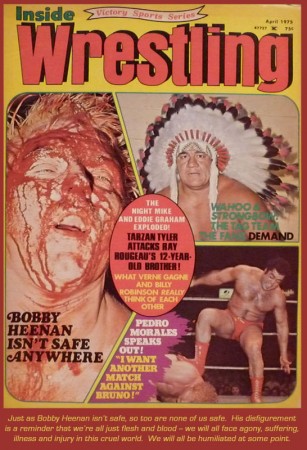 Between about 1972 and the mid-1980’s, it was common for pro wrestling magazines to feature blood-soaked photos on the cover. I call these “Crimson Covers” because of the crimson tone of the blood, which is usually highlighted against pale white skin or bright yellow or orange background colors for greater drama.
Between about 1972 and the mid-1980’s, it was common for pro wrestling magazines to feature blood-soaked photos on the cover. I call these “Crimson Covers” because of the crimson tone of the blood, which is usually highlighted against pale white skin or bright yellow or orange background colors for greater drama.
The more gore, the better. The Crimson Covers were nasty, and thrilling, and sickening, and provocative, and inappropriate, and inspired your sympathy all at the same time. But what was the purpose of these unusual and grotesque photos? What public itch was being scratched by these horrifying images? Here are a few theories on the reasons behind, and attraction to, the Crimson Cover.
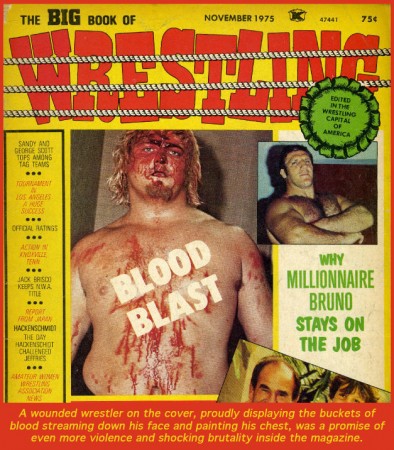 Injury Adds Realism
Injury Adds Realism
Pro wrestling is more believable if the athletes are seen to be hurt before your eyes. Being spiked into a brick wall seems more authentic if the face is cut in the process. After pro wrestling became televised, it became more difficult to conceal the pulled punches, the kicks that missed. The fakeness of the spectacle was becoming known, and the promoters figured the success of the sport depended on believeability. So bleeding was used as a method to maintain “Kayfabe”.
 Bleeding = Toughness
Bleeding = Toughness
Pro wrestlers entertain us by being Larger Than Life, or Tougher than the Average Man. Getting busted open, yet bravely continuing the match makes the bloody wrestler seem Bad-Ass and the battle seem more dramatic. In most sports, the match stops when someone is injured, but pro wrestlers are so fierce and powerful, they press on in spite of their injury.
One way to get the fans to buy in to a wrestler’s toughness is to bloody his face. The wrestler is then depicted as a living example of the famous line: “My head is bloodied but unbowed.”
 The Baby-Seal Effect
The Baby-Seal Effect
People naturally have compassion for cute creatures. They hate to see baby seals getting clubbed, or puppies being abused, because these creatures resemble human babies, which we’re genetically programmed to preserve and protect.
So seeing a “Baby-Face” wrestler busted open — his beautiful face maimed and grotesque with blood — tugs at our heart-strings. One way to inspire sympathy and compassion for the hero (which is really at the heart of every successful pro wrestling narrative) is to feature images of him in agony, his suffering clearly demonstrated by the undeniable, blatant, bright red blood pouring down his handsome face.
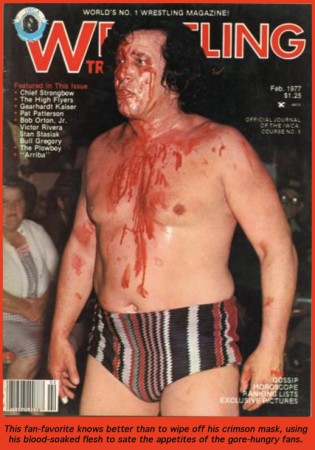 Gore is Fascinating
Gore is Fascinating
People enjoy being frightened by slasher movies, serial killer stories, and other disturbing topics. When there’s a car wreck, traffic slows down primarily so everyone can rubber-neck to see if someone was injured.
Crimson Covers satisfied the audience’s prurient sadistic interests. It’s thrilling to observe a violent scene — from a safe distance of course — to test the limits of your tolerance. Some studies have suggested that seeing graphic scenes of violence allow people to let off steam — which prevents them from acting out savage, brutal acts of anger themselves. Wrestling gave folks their blood-lust fix.
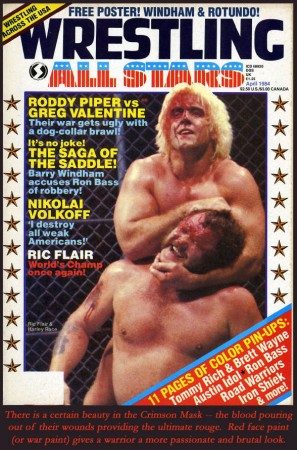 Performance Art
Performance Art
A face painted in red can be compelling and beautiful — like an abstract Picasso painting. The wrestler never wipes off the blood, so it pours out and disperses in a network of rivers and streams. It soaks his hair — which for blond wrestlers like Ric Flair creates an eye-catching contrast between white and red.
Then the blood drips around his eyes and down his cheek, framing his face. Some splashes down onto his chest, creating random but interesting ink blot patterns on his bare flesh or his opponent’s arms. Watching the blood slowly cover the wrestler’s face and body can be captivating, like watching a log burn or an icicle melt and drip.
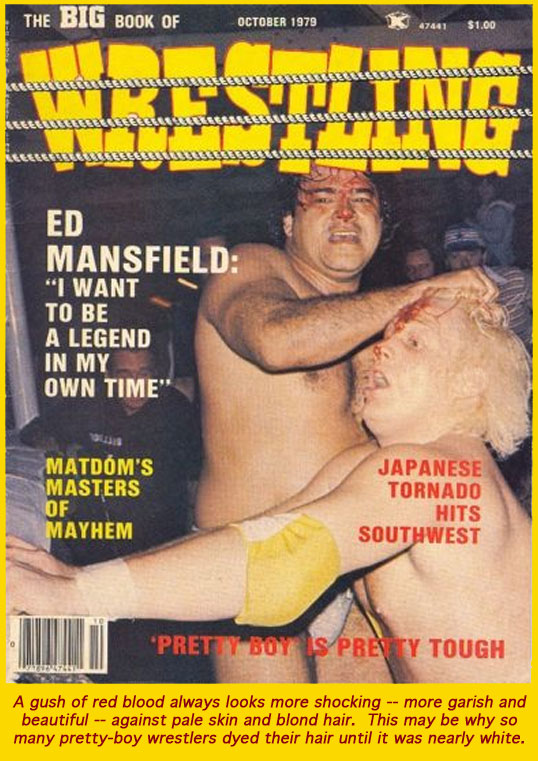
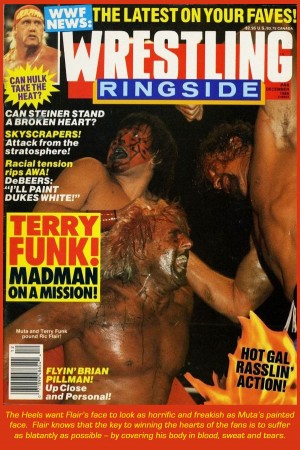 This Ain’t the Ballet
This Ain’t the Ballet
Young men (the typical pro wrestling fans) are eager to differentiate themselves from females, to establish and cement their maleness. They use their entertainment choices to set themselves apart from women and affirm their male identity.
Men therefore want to watch tough, testosterone fueled spectacles — the more violent the better. If their sisters, or grandmothers, or girl friends must shield their eyes from a scene, the male will be more compelled to watch it — to prove to himself and others that he’s tough enough and not a female. Violent, gory pro wrestling provides the litmus test for proving one’s manliness.
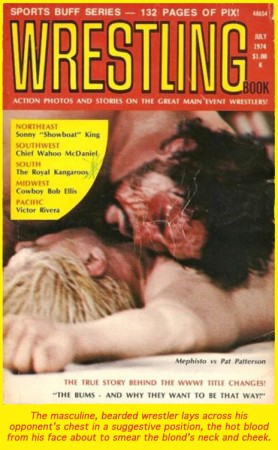 Sexual Connotations
Sexual Connotations
Bloodying someone’s face — “busting open” your opponent — is compelling to wrestling fans because it references sex. Opening a wound is a form of penetration. Leaving one’s discharge (whether blood or other fluid) on someone is an intimate act.
The reason Vampire stories are popular is the implied sexuality portrayed in the extracting and co-mingling of blood. Vampires (and, apparently, brutal heel wrestlers) lust for blood, for their victim’s essence. And the victim (or jobber) who willingly submits to the Vampire’s bite — who allows his blood to be spilled — is portrayed as being seduced or sexually conquered.
The face represents a person’s identity — it is the body part we interact with. So to disfigure or obliterate the face is to take away the person’s identity. This is the ultimate humiliation: transforming someone’s human form into something grotesque and unrecognizable.
The “facial” is common in pornographic scenes, and is considered a humiliating, raunchy, and hostile act. Bloodying another wrestler’s face has similar connotations to the “facial” scene in a porno — using bodily fluids to demean and obliterate the face.

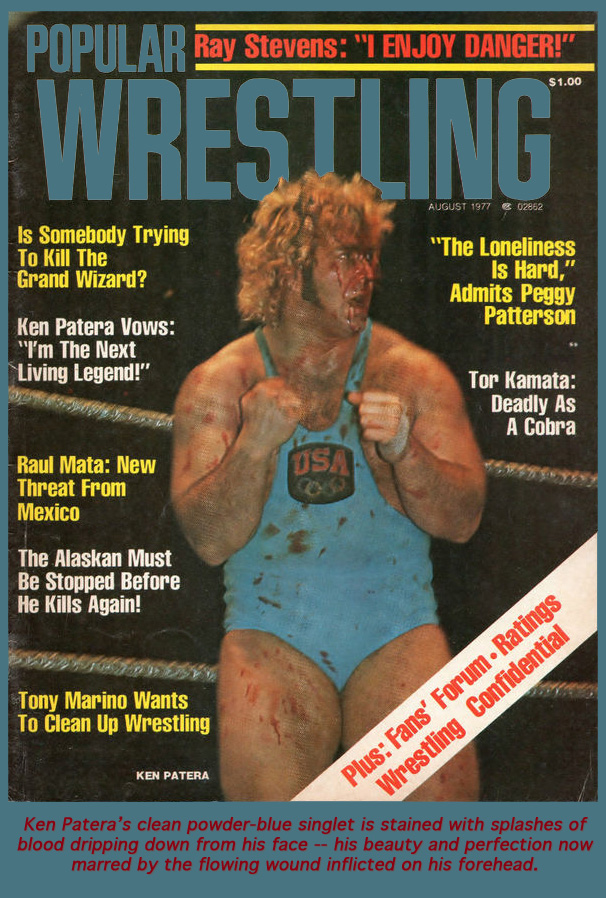
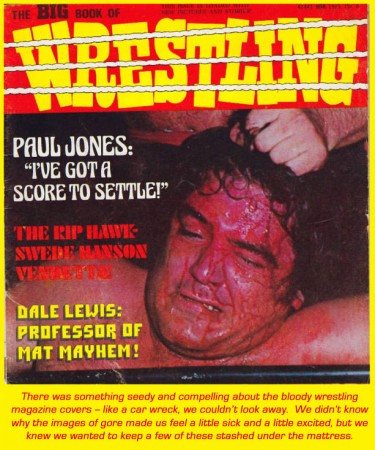
I LOVE CUTE, SEXY AND COCKY GUYS BLEEDING!!